Hoka One One Clifton 6
Test Locations: Gunnison & Boulder, Colorado
Test Duration (so far): 100 miles
Stated Stack Height: 27 mm (heel) / 22 mm (forefoot)
Stated Heel to Toe Drop: 5 mm
Stated Features:
- Embroidery reinforcement reduces layers and offers support and midfoot lockdown
- Reinforced eyestays provide increased durability
- Early stage Meta-Rocker offers a smooth ride
- Full compression EVA midsole provides signature HOKA ONE ONE® cushioning
- Moderate heel bevel gives a smooth transition
- Flat-waisted geometry provides inherent stability
- Full ground contact design
- Strategic high-abrasion rubber zones to reduce weight
MSRP: $130.00
Reviewer: 5’9, 115 lbs
Size Tested: US Women’s 8
Stated Weight Per Shoe (US Women’s size 8): 210 g / 7.4 oz
Blister Measured Weight per Shoe (US Women’s Size 8): 227 g / 8.0 oz
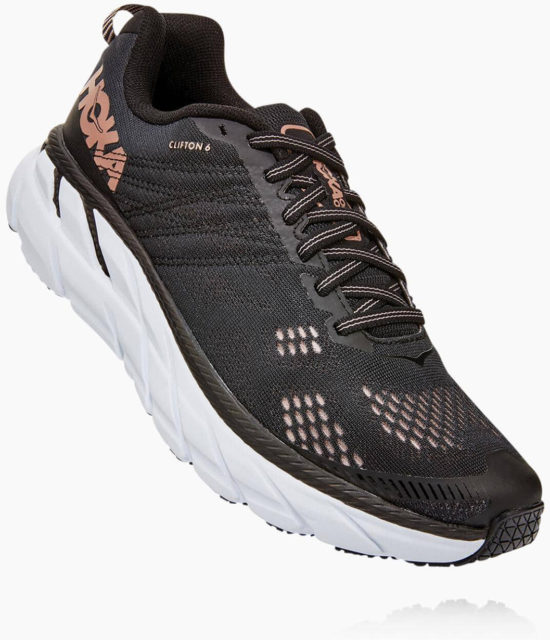
Intro
The Clifton is one of Hoka One One’s classic road shoes. Since the release of the original Cliffton in 2014, this shoe has gained a lot of fans due to its cushioned yet lightweight ride. The new Clifton 6 has similar features to past models, but Hoka claims it’s got a “smoother ride” and an embroidered design on the upper for a more locked-down fit without increasing the weight of the shoe. I have tested several of Hoka’s trail shoes as well as the previous Clifton 5 and was eager to see how the new Clifton 6 compared.
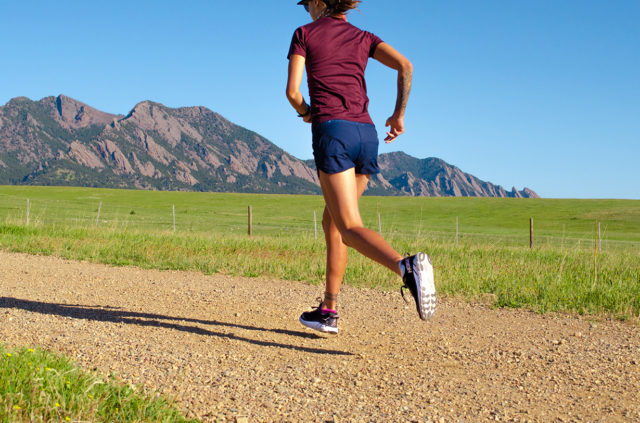
After about 100 miles in the Clifton 6, to me, the newest model felt like a better shoe than the Clifton 5 in just about every regard, making it become my go-to shoe for recovery days on pavement and smoother dirt paths / roads.
Fit
As always, we highly recommend trying on any shoe before purchasing, if possible. That said, here I’ll go over how the Clifton 6 fits my feet.
I’ve always had good experiences with the fit of Hoka’s shoes and my feet. While I have a relatively low-volume foot, I have bunions that make some shoes rather uncomfortable. Hoka claims that the Clifton 6 has a “more comfortable fit” than other models, which is admittedly a bit vague.
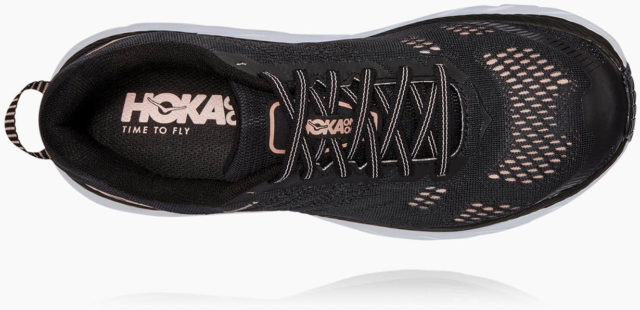
When I first put on the Clifton 6, I was impressed by the overall feel of the shoe. While the general width of the midsole feels pretty similar, the upper is stretchier than the Clifton 5, making the 6 fit in a more comfortable manner than the 5. The Clifton 6’s heel cup also has some additional padding which helps to better secure my foot in place.
I tested a women’s size 8, which is the size I normally wear, and I’d say the shoe fits true to size. I had enough room in the front to ensure that my toes were not squished, but not too much that it felt excessively large. With the addition of the more elastic upper, my foot was held snugly in place without being too tight.
Compared to other shoes I have worn, the Clifton 6 fits more snugly, particularly in the midfoot and forefoot, than the Hoka Challenger ATR 5 and Salomon Sense Ride 3. I have heard from others with higher-volume feet that the Clifton 6 does feel a bit tight in the midfoot and forefoot areas. Since my feet are fairly low volume, I did not have any issues with this, but the Clifton 6 does also come in a “wide” version which may be worth considering if you have a slightly higher-volume foot, or want a shoe that allows for more room in the forefoot.
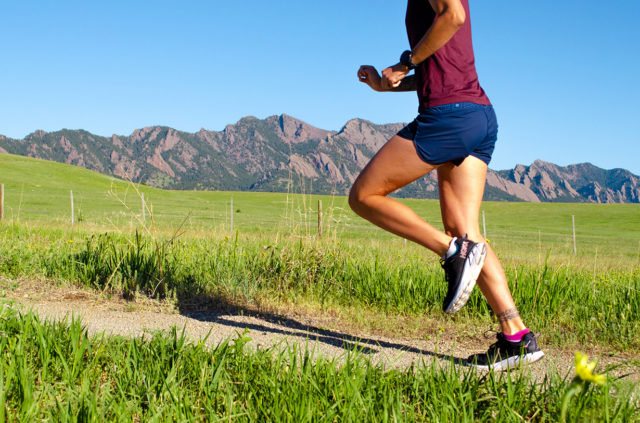
In both the Clifton 6 and the Challenger ATR 5, my foot sits down in the shoe and does not make me feel like I am running on top of the cushion, which is a sensation I felt when running in the Hoka Speedgoat 2. This is something I like as it helps make the shoe feel a bit more stable and secure.
All that said, the Clifton 6 still feels like a fairly “big” shoe — not in terms of it being loose, but more in terms of the midsole. The high stack height makes it feel a bit clunky, especially if you’re like me and typically run in lower-stack shoes. While I was still able to do quicker runs in the shoe, it wouldn’t be my first choice for a high-intensity workout.
Weight & Comparisons
For how cushioned this shoe is, the Clifton 6 is relatively light. While it is obviously not as light as a much more minimal / racing shoe, it is still lighter than some competitors (especially those with similarly maximal midsoles). Below are the stated weights of some other shoes in its class for reference. All weights are based on a US Women’s Size 8.
187 g / 6.6 oz — Hoka Rincon
192 g / 6.8 oz — Altra Duo 1.5
209 g / 7.4 oz — Hoka Clifton 6
215 g / 7.6 oz — Altra Torin 4
215 g / 7.6 oz — Hoka Clifton 5
243 g / 8.6 oz — Hoka Bondi 6
263 g / 9.3 oz — Brooks Ghost 12
309 g / 10.9 oz — Adidas Ultraboost 20
While the Clifton 6 does provide a lot of cushioning, it’s pretty light compared to other maximal road shoes. It does feel larger on my foot due to the thick midsole, but the Clifton 6 doesn’t feel quite as heavy as the previous iteration. I enjoyed how light the Clifton 6 felt, especially given how much cushion it provides.
Upper
The Clifton 6’s redesigned upper is primarily composed of a mesh material. The Clifton 6 has a new embroidered midfoot design in the place of the thicker overlays that are found on many other shoes. The less-stretchy, embroidered midfoot area is designed to help provide a more locked-down fit but with minimal material and bulk.
After the first few runs in the shoes, I definitely think that the Clifton 6’s upper feels much better overall than the Clifton 5’s upper. My foot feels securely locked down without having to tie the laces too tight and I haven’t experienced any excessive rubbing. Hoka also makes the Clifton 6 in ten different color combinations, so you’ve got plenty of choices.
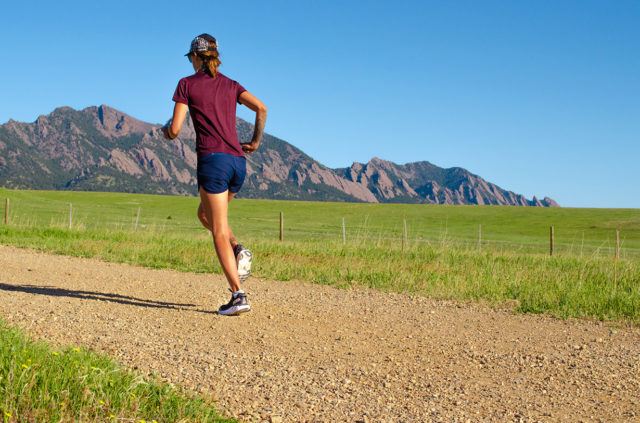
One complaint I’ve heard about the Clifton 6 is that the tongue of the shoe feels slightly too short. The tongue of the Clifton 6 is on the shorter side, as it ends just above the last eyelet for the laces, but I never found this to be a problem when running in the shoe. The laces never came above the tongue of the shoe and never caused any pain or rubbing for me. In addition, the tongue felt cushioned enough to help protect / cushion the top of my foot from the laces without being so thick that it felt excessively bulky. The Clifton 6 felt normal in terms of breathability; I never experienced issues with the shoe being too hot during any of my runs in it.
So far, the upper of the Clifton 6 is not showing significant signs of wear. While there are several creases in the toe from where my foot flexes, there is no apparent sign of tearing. In the past, the uppers of my other Hokas have held up even as the outsole showed more obvious signs of wear, usually around 400-500 miles. I would expect the uppers of the Clifton 6 to last the same, especially if you are using them predominantly on the road.
Midsole & Cushioning
Hoka labels the Clifton’s level of cushioning as “balanced,” which is the brand’s middle level of cushioning (between “responsive” and “plush”). The Clifton 6 has a “Full Compression EVA” midsole, and while this midsole provides an above-average amount of cushion, it is stiffer than I anticipated. This isn’t new for recent shoes in the Clifton line. The Clifton 6 does have a slightly lower stack height than the Clifton 5, which, in addition to the different nature of the midsole, also probably plays a role in how the new shoe feels.
When I see how much cushioning the Clifton 6 has, I expect it to feel like running on a pillow. But the Clifton 6 does not feel that way. The level of cushioning still kept my legs from feeling the impact of running long miles on pavement, but also didn’t feel particularly heavy or inefficient. The Clifton 6 still felt stiff through the midsole and in turn, I didn’t feel like a ton of my energy was simply being absorbed by the shoe.
The Clifton 6 felt much softer than the race-oriented Hoka Carbon X, but was not as soft as the New Balance Fresh Foam 1080v9. In terms of how much rebound / energy / pop it offers, the Clifton 6 felt less “poppy” or energetic than the Hoka Speedgoat, Hoka Carbon X, and Nike Vomero 13, but more energetic than the Hoka Challenger ATR 5 and Nike Pegasus 36 Trail. Unlike the Clifton 5, the Clifton 6 does produce a bit of spring / rebound after each step, which will be welcome news for a lot of Clifton fans.
I typically get slightly sore after a longer road run exceeding 15 miles in most shoes, but while wearing the Clifton 6, I haven’t felt the same soreness in my calves and quads. Hoka is well known for their highly cushioned shoes that are designed to reduce the impacts of running, and the cushioning on the Clifton 6 does just that, though its midsole is not as soft and “plush” as some of their other shoes or the first few iterations of the Clifton.
Like many Hoka shoes, the Clifton 6 features what the brand calls “early stage meta-rocker” which is designed to encourage a smooth stride and transition through each step. What this basically means in terms of the design is that the heel and toe of the Clifton 6 begin curving upward a bit earlier than many other shoes. The idea is that, especially with shoes like the Clifton 6 with tall stack heights, the rockered profile makes it easier to “roll” through each step.
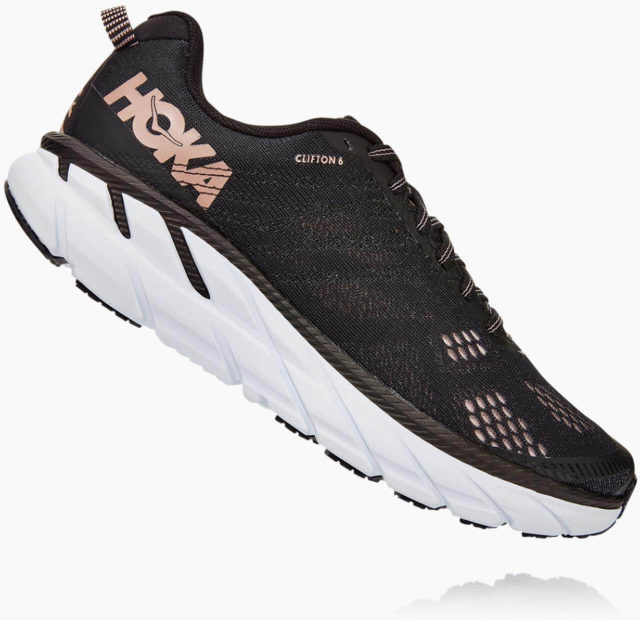
The Clifton 6’s rockered profile did contribute to the shoe’s smooth feel in my experience. When paired with the lightweight construction, the rockered profile makes each stride in the Clifton 6 feel smoother than I’d expect from its maximal design (whereas some highly cushioned, yet flatter-soled shoes can feel pretty clunky and slow).
As I mentioned above, the Clifton 6’s midsole is stiffer than I’d expected. One issue I experienced with the Clifton 5 was the length of time it took to break in that shoe due to the rigidity of its midsole. While the Clifton 6 still felt a bit too stiff upon taking them out of the box, after about 3 runs in the shoe I already noticed them softening up, which was much quicker than the Clifton 5. Overall, the Clifton 6 is slightly softer than the previous Clifton 5 and breaks in a bit faster. And while I have only put about 100 miles on the shoe, so far the midsole hasn’t gotten too soft for me.
Outsole & Traction
The Clifton 6’s outsole is one of the other main changes from the Clifton 5. The Clifton 6 has a new rubber pattern, which features a bit more rubber under the forefoot and slightly less rubber in the heel. This strategically placed rubber is designed to protect the midsole foam from excessive wear, while still being pretty light (the tread pattern is pretty flat with about half of the sole covered with rubber).
While I couldn’t feel a huge difference between the outsole of the Clifton 5 and 6, I did enjoy how the Clifton 6’s outsole performed — efficient on roads, but also offering enough rubber tread to provide adequate traction for running on gravel paths.
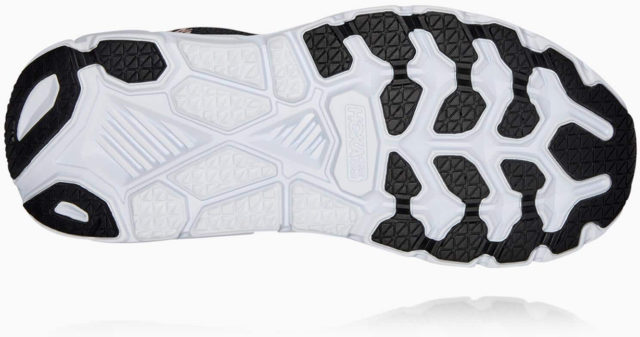
This fairly minimal outsole is designed for roads and I wouldn’t advise taking the Clifton 6 on a technical trail run. But for some miles on very flat, smooth trails, it does the trick. I enjoyed using this shoe on runs where I was linking gravel paths with pavement. The South Boulder Creek Trail is a gravel path I frequently run and the Clifton 6 lets me run efficiently on the roads over to the South Boulder Creek trail, then on the gravel path back to the roads a few miles away. If you are looking for a shoe that you’ll use mostly road running, but want the ability to run on flatter dirt trails or roads confidently, the Clifton 6’s outsole works well for that.
On the Road (& Trail)
The Clifton has been one of Hoka’s best selling road shoes for many years. While some models have been arguably better than others, I think the Clifton 6 is a better shoe than its predecessor. The Clifton 6 did not take as long to break in, felt lighter, more energetic, more forgiving through its midsole, and it fit my feet more comfortably than the Clifton 5.
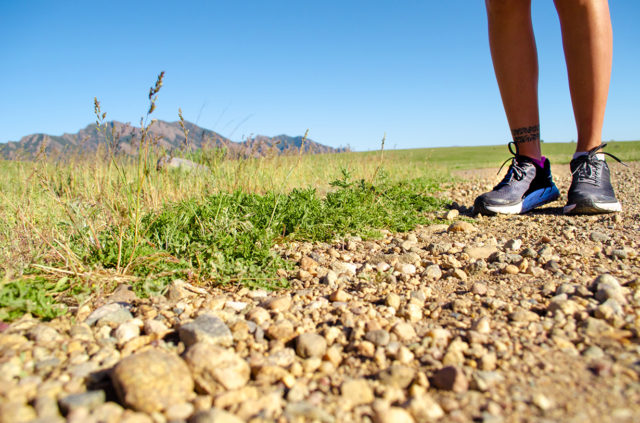
The Clifton 6 is a strong option for training runs on the road or smooth gravel paths. As I have mentioned, due to the amount of cushion, the shoe feels a bit bulkier than I would desire for workouts or fast running. Also, and this may go without saying for some, but since it is a road shoe with a minimal rubber outsole, I would not take it on technical trails or any runs where you have to run on slick rock, loose, or muddy conditions. But for training runs at a more mellow pace on roads or smoother trails, the Clifton 6 is a solid option.
Durability
After about 100 miles in the Clifton 6, they aren’t showing any significant signs of wear (not much surprise, given the mileage so far). The upper has some creases where my foot flexes, but these spots show no sign of tearing. The laces stretched out a bit during the first few runs, but this is something I have often found with the laces on other Hoka shoes. By the 3rd run or so, I didn’t feel the shoe loosening at all. And then the outsole is showing very minimal signs of wear so far.
When I reach 300-400 miles, I will provide an update to how the shoe is holding us, as this is when I have tended to see more wear on the other Hoka shoes I’ve used.
Who’s It For?
The Clifton 6 is a strong option if you are looking for a highly cushioned road running shoe. If you have run in a previous model of the Clifton, I would say the updated version is worth trying. The shoe still has the traits that make the Clifton a good shoe, including a lightweight design, a comfortable upper, and lots of cushioning. But the Clifton 6 has a more forgiving midsole and slightly more secure and comfortable upper than the Clifton 5, and takes significantly less time to break-in.
While it’s a bit softer than the previous iteration, the Clifton 6 is still not a soft, plush shoe like the Nike Vomero 13 or the Adidas Ultraboost. So if you’re looking at more maximal shoes to primarily absorb every impact during your run, I’d look to those shoes over the Clifton 6. It’s also worth noting that, while the Clifton 6 is designed for road running, it performs well on gravel roads or very smooth trails as well — just be aware that this will make the outsole wear down more rapidly.
If you are looking for a shoe for fast workouts or racing but still want some cushion, I would recommend looking at some of Hoka’s more race-focused shoes, such as the Carbon X or the Evo Rehi, as they’ll be better suited to fast running than the Clifton 6. In addition, if you don’t want a maximally cushioned shoe, or want a very soft cushioned shoe, I wouldn’t recommend the Clifton 6.
But, if you are looking for a pretty efficient, yet highly cushioned shoe that will help keep your legs from getting wrecked on long road runs, the Clifton 6 is a solid candidate. While I was slightly worried that the Clifton 6 would feel too similar to the Clifton 5, I was very impressed by the improvements from the previous model.
Bottom Line
The Hoka One One Clifton 6 offers improvements over the previous model that I feel make the 6 a better shoe for most people. The Clifton 6 is highly cushioned without being super soft, making it still fairly efficient for its level of cushioning, and I think its slightly more forgiving midsole and more comfortable fit will make it more appealing to many runners vs. the previous Clifton 5. While it is not my first pick for fast running, the Clifton 6 is a great option for average training days on the road.

The Clifton is my go to shoe but i have to cut out part of the upper on my left foot otherwise i will get black #2 and #3 nails on that side and i usually put in a different foot bed and i like changing the laces to those bungie type laces. If i do this and wear toe socks (thin Injinjis) life is pretty good. I always throw away my shoes at 300 miles as i find i get problems sometimes otherwise. I do like the fit better in their race shoes but the cushioning per shoe weight in the Clinton is the best i have ever run across.
I’ve been using the Bondi ever since the 3 version. Any sense of how the Clifton compares to the Bondi? My primary need is cushioning.
Clifton and Bondi cushioning are almost equal although the Clifton is very slightly more cushioned. The Bondi weighs more. The Clifton has a larger heel drop than the Bondi. You might look at this https://fellrnr.com/wiki/Hoka_Bondi I vastly prefer the Clifton to the Bondi although i have not run in the newest Clifton yet.Or the newest Bondi for that matter! so – old Bondi seems clumsy compared to the old Clifton and the cushioning is about the same.